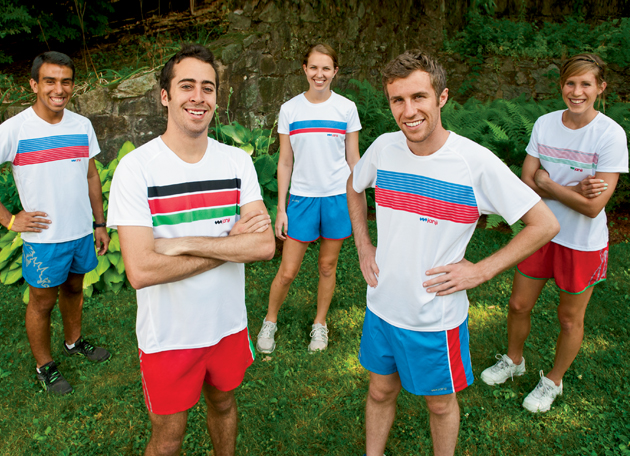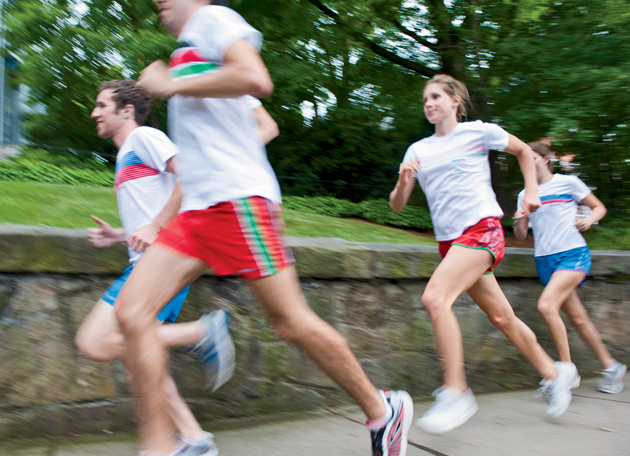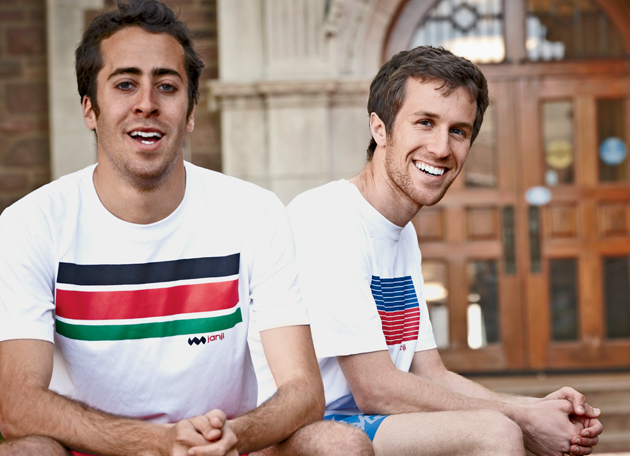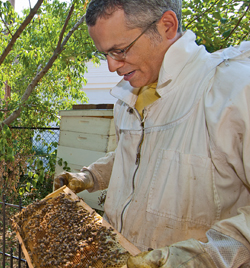
“In just a few years, you might be the leader of a highly successful new enterprise,” Chancellor Mark S. Wrighton told the Class of 2012 graduates at the Commencement ceremony in May.
He assured them: “Well-educated people like you can make a difference by applying new knowledge in creative ways.” The hoped-for outcome? “The impact from innovation and entrepreneurship can be profound, both in financial terms and in effecting positive social change.”
Running to solve the food and water crisis
Lift Kenyans out of poverty through access to adequate, clean water. Feed the malnourished in Haiti.
That’s the promise of Janji: Run for Another, a socially conscious running apparel company founded by Dave Spandorfer, AB ’11, and Mike Burnstein, AB ’12, while they were undergraduates.
Varsity runners while at Washington University, Spandorfer and Burnstein fashioned the idea that has become Janji on a bus trip to the 2010 Division III Outdoor Track & Field Championships.
“We wanted to find a way for runners to give back outside of race day. We’d seen other companies use apparel or shoes as a means to give back, so the first thing we thought of was to apply that to running apparel.”
—Mike Burnstein, AB ’12
“It was the idea of helping others,” Burnstein recalls. “We weren’t exactly sure what the cause was going to be.”
The two knew that runners frequently take part in road races that support social causes, ranging from local libraries and school districts to medical research. But they also wanted to do something that would have impact beyond a single race.
“We wanted to find a way for runners to give back outside of race day,” Burnstein says. “We’d seen other companies use apparel or shoes as a means to give back, so the first thing we thought of was to apply that to running apparel.”
What followed, Burnstein says, was the idea to link the sale of apparel “to the biggest cause we could find, which is what we call the global food and water crisis.” They believed runners would feel especially connected to their cause because of the importance of being hydrated and properly nourished to participate in their sport.
Spandorfer and Burnstein wanted to support sustainable, long-term solutions and to work with stable organizations in different parts of the world. They settled on Haiti, one of the world’s most impoverished nations and where malnutrition in children is endemic, and on Kenya, where 17 million people lack access to sufficient clean water. In Haiti, they are partnering with Meds & Foods for Kids (MFK), started by Patricia Wolff, MD, professor of clinical pediatrics at the School of Medicine. MFK produces a nutritious peanut-butter-based food — made by Haitian workers — known there as “Medika Mamba” (peanut butter medicine).
In Kenya, the organization is KickStart, which sells water pumps that help farmers irrigate their crops, generating more food for their families and providing them with enough produce to sell. The goal is to help people get out of poverty and create lasting change in their lives. Kenya also had the appeal of being a powerhouse in long-distance running.

Listenning to coaches
While Spandorfer and Burnstein had the idea for their venture, they didn’t have the know-how. They, therefore, turned to the Skandalaris Center for Entrepreneurial Studies, where Burnstein had completed a sophomore internship with a nonprofit startup, HavenHouse, and where he served as an ambassador for the center with the student community.
“The best way to get involved in entrepreneurship at Wash. U. is to involve yourself with the Skandalaris Center,” Burnstein says.
The two entered their venture, then called Life Shorts, in IdeaBounce, which is both a website for posting entrepreneurial ideas and a forum where “bouncers” present two-minute pitches before a panel of judges. Spandorfer remembers the day of their presentation as “chaotic” because he was simultaneously responsible for a lecture being presented to Phi Alpha Theta, the national history honorary.
After their IdeaBounce presentation, Ken Harrington, managing director of the Skandalaris Center, suggested two things: that they enter the center-sponsored YouthBridge Social Enterprise and Innovation Competition (SEIC) and that they take the Hatchery course. In the Hatchery (Business Planning for New Enterprises), students form teams around a venture idea; deliverables include two presentations to a panel of judges and a complete business plan.
“We tried to get as much feedback as we could from runners, from running-store owners, from people who have supported entrepreneurism. We wrote our business plan, and the feedback we got was fantastic.”
—Dave Spandorfer, AB ’11
Spandorfer says the Hatchery class proved to be a “boot camp for our idea,” which by then had changed its name to Edele. The two recruited other cross country team members: David Hamm, Architecture Class of ’13, as designer, and Kenny Fairleigh, BSME ’11, as the operations person. They also recruited Sarah Fisher, Arts & Sciences Class of ’14, who had previous experience working in a running store, to help them with public relations.
“We tried to get as much feedback as we could from runners, from running-store owners, from people who have supported entrepreneurism,” Spandorfer says. “We wrote our business plan, and the feedback we got was fantastic.”
In January 2011, they entered the YouthBridge competition and won a total of $15,000 — the $10,000 Skandalaris Award and a $5,000 award for the best student venture.
“That funding enabled us to get started, but more importantly it gave us confidence,” Spandorfer says. “I do believe that without the help of the Hatchery, the SEIC and Ken Harrington, this would never have gotten off the ground.”
Their idea continued to gain momentum when they entered another business plan competition, the 2011 University of Colorado at Colorado Springs (UCCS) Sports/Outdoor Business Plan Competition. Beating out 15 other teams — mostly graduate students — the team won the first-place prize of $20,000.

Approaching the starting line
When Spandorfer graduated from the university in May 2011 with majors in history and international business, Edele (now renamed “Janji,” meaning “promise” in Malay) was still primarily an idea. Over the next year he worked part time at Big River Running Co. in St. Louis and worked to develop the business idea.
The shorts and shirts Janji first produced were designed by Hamm, who also came up with the phrase, “Run for Another.” The flags of the countries where Janji has partnerships inspired the designs.
The team decided to launch their product in spring 2012, when Burnstein would graduate with a major in urban studies and a minor in entrepreneurship and when they would have an infrastructure in place.
Their initial launch was May 3, 2012, at Big River Running Co. in St. Louis. Over the summer they had launch parties in Philadelphia; Louisville, Ky.; Detroit; Cincinnati; Chicago; Boston; Atlanta; and Anchorage, Alaska.
They also moved Janji’s headquarters to Boston, after considering other places around the country. In Janji’s blog, Spandorfer wrote their criteria included a great startup culture, a vibrant running scene, a socially active community with nearby running apparel companies, and a place that was close to family.
The short-term goals for Janji, Burnstein says, are to grow awareness of the company’s products and to spread the word about its social mission throughout the running community. “We can make the biggest possible difference once people have heard of us and know where to find us,” Burnstein says.
“Long-term, we want people to consider the way they view running, and to know that they can make a difference with every piece of apparel they wear and every run they go on.”
Assisting the founders over the summer were three full-time interns — all runners — from the Class of ’14 who received stipends through Washington University’s Career Center. While everyone did a little bit of everything, Fisher, a psychology major and pre-med student, conducted public relations and worked with the running stores on launch parties. Justin Rodriguez, a mechanical engineering major, worked on inventory management and fulfillment, and Henry Clements, an Arabic and economics major, assisted with finance and fulfillment work.
Another of Janji’s key members is graphic designer Anna Shafer-Skelton, AB ’11, BFA ’12, who has been with the company for just over a year designing brochures and catalogs.
Running a company
In spring 2013, Janji: Run for Another will add apparel for Tanzania (clean water), Rwanda (nutritional medicine) and Bangladesh (seeds to grow gardens and crops) to their list of countries and causes.
The young entrepreneurs advance the similarities between entrepreneurship and long-distance running. “In both cases, you have to think long-term,” Burnstein says. “When you’re running a distance race, you make decisions at the beginning that don’t necessarily impact you until later on. In a company, it’s the same way, where you make a decision early on yet don’t know how it’s going to turn out until much later. ”
And where is Janji in its distance race?
“The gun has gone off, for sure, which is great,” Fisher says.
Burnstein concurs. “After the gun goes off, everyone sprints to get into position. The goal is to position yourself so that you have room to get into your comfortable stride.”
Spandorfer believes Janji is at about mile two of a marathon. “We have our training behind us. We’ve had some good food; we’re well hydrated,” he says. “But we’ve got a long way to go.”
Mary Ellen Benson is a freelance writer and a former executive editor of this magazine.


Comments and respectful dialogue are encouraged, but content will be moderated. Please, no personal attacks, obscenity or profanity, selling of commercial products, or endorsements of political candidates or positions. We reserve the right to remove any inappropriate comments. We also cannot address individual medical concerns or provide medical advice in this forum.